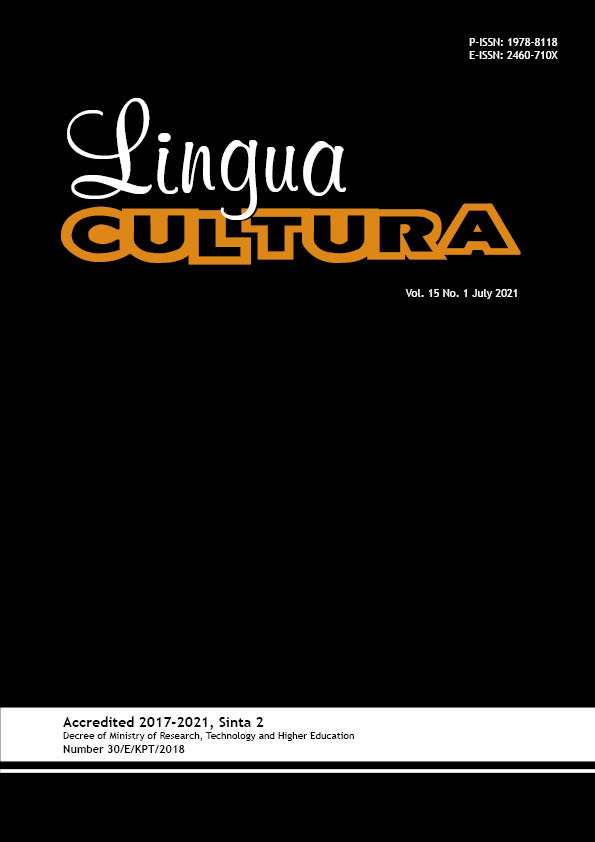Ana Dhei Dhato: A Traditional Wedding Tradition at Rajawawo Village of Ende Regency
DOI:
https://doi.org/10.21512/lc.v15i1.7040Keywords:
traditional wedding, wedding tradition, Ana Dhei DhatoAbstract
The research aimed to describe each process of ‘Ana Dhei Dhato’ and revealed its cultural meanings based on the perspective of people in Rajawawo village of Ende regency. The research applied a descriptive qualitative. In collecting data, interviews, note-taking, and recording were conducted. The data were analyzed through transcribing and translating. The analysis results show that ‘Ana Dhei Dhato’ is considered the most valuable type of wedding because of its complexity and peculiar characteristics. It can be seen from the way they run this kind of wedding ritual. Some cultural meanings are found in these wedding rituals and language spoken, such as religious meaning, social meaning, historical meaning, juridical meaning, and didactic meaning. Therefore, it is expected that people in Rajawawo village must consider ‘Ana Dhei Dhato’ as one of the most valuable cultural heritages and should also maintain its existence.
References
Akbar, M. A., Laksana, K. D., Artawa, K., & Sukri, M. (2020). Sasak lexicon in traditional marriages: A linguistic anthropology perspective. The International Journal of Language and Cultural, 2(2), 8-13. https://doi.org/10.5281/zenodo.4059936.
Al-Mansoob, N. T., Patil, K. S., & Alrefaee, Y. (2019). A cross-cultural study of the speech act of compliments in American English and Yemeni Arabic. Langkawi: Journal of The Association for Arabic and English, 5(1), 1-12. https://doi.org/10.31332/lkw.v5i1.1271.
Aso, M. S., & Sujito (2016). A study on symbols used in So’a Para Zedhe ceremony. Jurnal Bahasa dan Sastra, 3(1), 49-65.
Creswell, J. W. (2009). Research design (3rd Ed). California: SAGE Publications, Inc.
Hidayati, H. (2018). Local wisdom of Kembar Mayang in wedding tradition of Jawa ethnic. Language Literacy: Journal of Linguistics, Literature, and Language Teaching, 2(1), 17-27. https://doi.org/10.30743/ll.v2i1.552.
Hodairiyah, H., Rais, W. A., & Purnanto, D. (2019). The cultural meaning in verbal and non-verbal expression represented in Nyaébuh tradition of people in Aeng Tong-tong, Saronggi, Sumenep. Lingua Cultura, 13(4), 283-287. https://doi.org/10.21512/lc.v13i4.5933.
Jumino, J. (2019). Symbolic meanings in marriage ceremony of Javanese culture (Semiotic analysis). Proceeding of the First International Conference on Culture, Literature, Language Maintenance and Shift. Semarang, Indonesia. pp 120–124. https://doi.org/10.4108/eai.13-8-2019.2290211.
Kami, P., Simpen I. W., Yadnya, I. B. P., & Laksana, I. K. D. (2020). Language choice of Ende- Nage speakers: A sociolinguistics study. The International Journal of Language and Culture, 2(1), 58-74.
Kartolo, R. (2017). Language meanings and symbols in the traditional wedding ceremony of Malay Deli. The International Journal of Social Sciences and Humanities Invention, 4(7), 3679-3685. https://doi.org/10.18535/ijsshi/v4i7.16.
Kupper, A., & Jesica, K. (2000). Ensiklopedi ilmu-ilmu sosial. Jakarta: Raja Grafindo Persada.
Langkameng, A., & Latupeirissa, S. (2020). Cultural values of Oko Mama: Marriage proposal ritual speech in Bokong community, Indonesia. The International Journal of Language and Cultural (TIJOLAC), 2(1), 48-57.
Mehmet, D. (2017). Tracing the local culture in a reading book. Journal of Languages and Culture, 8(9), 141-146. https://doi.org/10.5897/jlc2015.0337.
Mubarokah, Q., Djatmika., & Sumarlam. (2019). Cucuk Lampah: Cooperative principles violations to create laughter at wedding ceremony in Magetan. Lingua Cultura, 13(3), 231-237. https://doi.org/10.21512/lc.v13i3.5747.
Nengsih, M. S., & Syafwandi, S. (2020). The symbolic meaning of the tradition “Hantaran Jamba Badagang†in a wedding party Ceremony at Kambang Lengayang sub-district, Pesisir Selatan. International Journal of Educational Dynamics, 2(1), 99-112. https://doi.org/10.24036/ijeds.v2i1.238.
Panjaitan, I. P., & Manugeren, M. (2019). Symbolic meanings of Kembar Mayang in Javanese wedding ceremony at desa Medan Sinembah kecamatan Tanjung Morawa kabupaten Deli Serdang. Journal of Language, 1(1), 1-10. https://doi.org/10.30743/jol.v1i1.1123.
Passandaran, Y. M. (2019). The semiotic representation analysis of wedding ceremony in West Sumatera province. Human Narratives, 1(1), 45-54. https://doi.org/10.30998/hn.v1i1.24.
Rahman., Zakaria., Tristiantari, N. D., & Sakti, A. W. (2020). An analysis of symbolic meanings in Palang Pintu tradition of the Betawi wedding ceremony. Proceedings of the 4th International Conference on Language, Literature, Culture, amd Education (ICOLLITE 2020). Pp 599-604. https://doi.org/10.2991/assehr.k.201215.093.
Rudiyanto., Rais, W. A., & Purnanto, D. (2020). Etnolinguistics study: Cultural meaning of Sranan tradition as a form local wisdom of mountain farmer society in Kebumen. Prosiding Seminar Nasional Linguistik dan Sastra, 1, 543-552.
Septiana, D., Santosa, R., & Sumarlam, S. (2019). Riak in Dayak Maanyan ritual tradition (An ethnolinguistics study). Langkawi: Journal of The Association for Arabic and English, 5(2), 79-90. https://doi.org/10.31332/lkw.v5i2.1378.
Silalahi, P. V. (2019). The semiotics of Batak Toba society marriage tradition. PARAFRASE: Jurnal Kajian Kebahasaan & Kesastraan, 19(2), 111-118. https://doi.org/10.30996/parafrase.v19i2.2792.
Singh, R. (2018). A cognitive approach to the semantics in the sacred context: Semantic and symbolic function of sacred words. English Linguistics Research, 7(3), 1-6. https://doi.org/10.5430/elr.v7n3p1.
Sudaryanto. (2015). Metode dan aneka teknik analisis Bahasa. Yogyakarta: Sanata Dharma University Press.
Downloads
Published
How to Cite
Issue
Section
License
Copyright (c) 2021 Wendelinus Janggo

This work is licensed under a Creative Commons Attribution-ShareAlike 4.0 International License.
Authors who publish with this journal agree to the following terms:
a. Authors retain copyright and grant the journal right of first publication with the work simultaneously licensed under a Creative Commons Attribution License - Share Alike that allows others to share the work with an acknowledgment of the work's authorship and initial publication in this journal.
b. Authors are able to enter into separate, additional contractual arrangements for the non-exclusive distribution of the journal's published version of the work (e.g., post it to an institutional repository or publish it in a book), with an acknowledgment of its initial publication in this journal.
c. Authors are permitted and encouraged to post their work online (e.g., in institutional repositories or on their website) prior to and during the submission process, as it can lead to productive exchanges, as well as earlier and greater citation of published work.
USER RIGHTS
All articles published Open Access will be immediately and permanently free for everyone to read and download. We are continuously working with our author communities to select the best choice of license options, currently being defined for this journal as follows: Creative Commons Attribution-Share Alike (CC BY-SA)


















